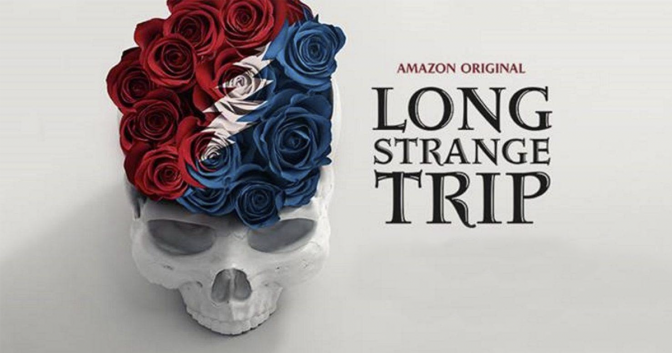Review: ‘Long Strange Trip’ Grateful Dead Documentary

Berkeley, Calif.-born Deadhead Amir Bar-Lev didn’t set out to make a four-hour-long documentary about his favorite band when he started working on Long Strange Trip, but like a vintage Grateful Dead concert, the final result just mushroomed into its epic length.
In this Golden Age of rock docs, Long Strange Trip raises the—pardon the expression—Bar for the form. In its six parts, he explores the peaks and valleys of the Grateful Dead story, often detouring into fascinating tangents, from the band’s roots in Beat culture and the early Acid Tests to its fabled Owsley-designed “wall of sound,” dedicated road crew and troubling relationship with the Hell’s Angels to the fervent Deadhead scene that followed the group everywhere. It’s like a Russian novel, with the Dead’s influence rippling outwards like a pebble thrown in the middle of a pond.»
If you’re making a movie about music, it should be musical,” the 45-year-old filmmaker, who now lives in Brooklyn, tells Freedom Leaf. “We tried to set the medium to the message. The film itself is like the Grateful Dead and, hopefully, mirrors the structure of their songs, where everybody solos at once.”
The movie takes as one of its leitmotifs the story of Frankenstein, which fascinated guitarist Jerry Garcia from the time he was six, when his mother took him to a showing of Abbott & Costello Meet Frankenstein less than a year after his father drowned in a boating accident.
“That was obviously an impactful experience in Jerry’s life,” notes Bar-Lev, who’s also directed The Tillman Story, My Kid Could Paint That, Fighter and Happy Valley. “It terrified him, and at the same time made him resolve not to have that fear control him. From an early age, Jerry tried to confront and embrace things that were not just different, but repellent to him.”
The film is fueled by thoughtful interviews with the remaining original band members—singer/guitarist Bob Weir, bassist Phil Lesh, and drummers Bill Kreutzmann (his son Justin is one of the producers) and Mickey Hart—as well as with former manager Sam Cutler, former road manager Steve Parish, longtime publicist Dennis McNally, backup singer Donna Godchaux, Weir-song lyricist John Perry Barlow, former Warner Bros. Records’ president Joe Smith, and Garcia’s daughter Trixie and ex-girlfriend Barbara Meier. Among those omitted are the late concert promoter Bill Graham, Garcia-song lyricist Robert Hunter, and Garcia’s wives Carolyn Adams (a.k.a. Mountain Girl) and Deborah Koons.
Thanks to their participation as the house band at the Acid Tests conducted by Ken Kesey and his Merry Pranksters in the mid-’60s, the psychedelic experience is placed front and center in Dead lore; the film includes vintage footage of early CIA experiments with LSD and those under the influence trying to describe its preternatural effects. Another of the film’s recurring themes is the Watts Towers in Los Angeles, which evoked within Garcia an acid vision that his work should never solidify into a single solid shape, but remain open-ended and in the moment. It’s as good an explanation as any as to why the Dead preferred live concerts to the permanence of recording.
Writer-fans like New Yorker contributor Nick Paumgarten, Steve Silberman and Sen. Al Franken (who ruminates on his favorite live version of “Althea”) are summoned to articulate the Dead’s musical and cultural significance, but the movie is strongest when it provides first-hand recollections of specific performances, such as a recording engineer’s astonished memory of Garcia’s solo on “Morning Dew” at the Lyceum Theater in London, captured on Europe ’72. In one of the centerpieces, Bar-Lev juxtaposes still photos, live footage and first-person memories to construct a poignant mise-en-scène.“Sometimes photos allow you to listen to the music better than live footage can,” observes Bar-Lev about the segment.

Jerry Garcia in front; in back, from left: Bill Kreutzmann, Ron «Pigpen» McKernan, Bob Weir, Mickey Hart and Phil Lesh
“Sometimes it’s the transition from photos to film and back that telegraphs something imperceptibly to the audience, guiding them to where you want their attention to be. One of the things I learned from the Dead is making every part of the endeavor creative. The band never drew a distinction between playing onstage from what the roadies or the people selling the tickets were doing. And that’s how we did this movie. No one person was any more important than anyone else.”
The director gets coy when asked if he’d ever taken acid himself. “That’s against the law,” he offers. “I can’t talk about that, but I will say this: I’m either the most intuitive journalist alive, or I’ve had some experience in these matters.”
As celebratory as Long Strange Trip is, it doesn’t overlook the various tragedies that have pockmarked the Dead’s journey, with the deaths of band keyboardists Ron “Pigpen” McKernan, Keith Godchaux and Brent Mydland; Garcia’s declining health due to his heroin addiction; and the enormous Deadhead scene that began to overwhelm the band.
If Pigpen’s death in 1973 signaled the end of the Dead’s innocence—and the band’s departure from its bluesy roots—and Garcia’s 1986 coma was the impetus for the band’s “Touch of Gray” commercial breakthrough a year later, it’s appropriate that Garcia’s death in 1995 marks a convenient ending for Long Strange Trip.The movie’s final segment offers a clear-eyed look at the guitarist’s descent, closing the chapter on the Grateful Dead.

From left: Phil Lesh, Bob Weir, Jerry Garcia and Bruce Hornsby
“The Dead were a conduit for some life force bigger than them that will outlast all of us,” says Bar-Lev about the film’s denouement. “I feel like the film needed to end on a baton pass to everyone in the audience. It wasn’t about current Dead lineups, the legacy of jam bands in their wake or anything else. I needed to personalize the ending, because that’s how I felt. Jerry talks about getting something from Jack Kerouac, putting him into the life he lived. As a journalist, I’m just hoping, in some small way, a kid watching this movie in the future will tap into the same continuum.”
Long Strange Trip, which can be viewed on Amazon Prime, does just that, the kind of lasting monument Garcia early on decided he didn’t want to leave, taking the Watts Towers as an example of that sense of ever-changing permanence.
“The Grateful Dead weren’t just the guys onstage, but a phenomenon that included so much more,” explains Bar-Lev. “I couldn’t treat these guys like rock stars on an episode of Behind the Music. They insisted that we not put them on a pedestal, and see ourselves as co-creating the magic. Even if you walk away not a fan of the Grateful Dead, at least you can understand where they’re coming from.”
Indeed, Long Strange Trip is not just for Deadheads, but also for music fans and students of counterculture history. All 240 minutes of it.
If you enjoyed this Freedom Leaf article, subscribe to the magazine today!


